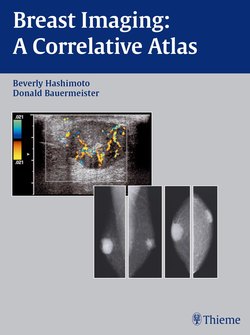Читать книгу Breast Imaging - Beverly Hashimoto - Страница 18
На сайте Литреса книга снята с продажи.
ОглавлениеCase 4
Case History
A 73-year-old professional violinist presents for a screening mammogram. She has a history of a soft mass in the upper outer left breast for more than 20 years.
Physical Examination
• left breast: very soft area of asymmetry in the upper outer quadrant
• right breast: normal exam
Mammogram
Mass
• margin: circumscribed
• shape: round
• density: fat-containing
Associated Findings
• completely fatty encapsulated mass in the upper outer quadrant of the left breast (Fig. 4–1)
Figure 4–1. Right MLO mammogram: There is a large, well-defined radiolucent lipoma. The small nodule that projects in the center of the mass is a lymph node located just medial to the lipoma on the CC view.
Ultrasound
Frequency
• 11.5 MHz
Mass
• margin: well defined
• echogenicity: isoechoic
• retrotumoral acoustic appearance: no shadowing
• shape: ellipsoid (Figs. 4–2 and 4–3)
Figure 4–2. Left radial breast sonogram: Combined images of the upper outer quadrant show the margins of the lipoma (arrows). The mass created by the lipoma pushes the thin hyperechoic parenchymal lines (representing lobular regression) superiorly.
Figure 4–3. Left radial breast sonogram: Sonogram is in a normal portion of the same breast as Figure 4–2. This image is intended to demonstrate the normal architecture of the fatty breast parenchyma. F, fatty breast parenchyma; C, Cooper's ligaments; M, chest wall muscle.
Pathology
• lipoma
Management
• BI-RADS Assessment Category 2, benign finding
Pearls and Pitfalls
1. Mammographic fat-containing masses are benign so sonographic examination is generally not necessary. However, occasionally, a patient is referred for sonography for a palpable fatty mass that has not been mammographically characterized. In these cases it is important to be familiar with the sonographic appearance of fatty masses and recommend mammography to confirm the benign identity of the mass.
2. Sonographically, lipomas are generally oval and well defined. They are hypoechoic, isoechoic, hyperechoic, or heterogeneous in echogenicity. In a fatty breast, isoechoic tumors are sometimes difficult to identify. However, this case emphasizes that lipomas do not have the same internal architecture as normal fatty parenchyma. The echogenic lines within the lipoma do not follow a normal pattern of lobular regression.
Suggested Readings
1. Fornage BD, Tassin GB. Sonographic appearance of superficial soft tissue lipomas. J Clin Ultrasound 1991;19:215–220.
